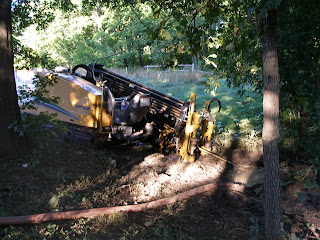A Question of Priorities
I was intrigued by our trip on Saturday, to see an example of
Permaculture in action, I understand the concept of mutualistic systems
and of taking advantage of all areas to increase production in food. My
biggest question though, as a student who is interested in repairing
damaged ecosystems, is how does this impact the environment if we are
altering soil contidions, altering topography and landscapes and
introducing plants that would normally not be seen in this area? How do
these alterations and introductions change the biota? Is it possible to
utilize this theory with native species? I am interested in this
question for my final project for the class. On the other hand, I was
interested in the orchard area, as it seemed to be the most fully
developed example of Polyculture design.
Good questions.
In the Homestead area and built environment we find disturb soil
and areas that have been previously altered. In the Permaculture zone
system, one through 5, you will see that zone 5 is the natural space.
Much of the area on Southwoods that we see but did not walk in his
undisturbed wetland or woodland. The areas that we traveled were
obviously altered from their natural state sometime ago. This is a tough
balance for our Homestead that is trying to be sustainable in its
horticultural products for the occupants while respecting the natural
capital and ecosystem that surrounds it.
In every project where I have done earthworks, the soils have been
turned over and depleted either by construction or agriculture. In
building a slight change in topography whereas we can catch water on the
land we are beginning and accelerating its repair. In Permaculture much
of the time we are trying to accelerate succession so that we can
benefit from it more quickly or at least during our lifetime. By
building the swales on a hill we are adding structure to catch and store
the natural energies and resources on the land that otherwise would be
lost. Centuries ago the soil was deep and most likely heavily wooded or
in the Prairie. These areas caught and held the sunlight and the water
that fell on them and were only subject to disturbances from wind and
fire, with the occasional micro disturbance of pocket gophers, badgers,
and Buffalo that turned the soil. There is no reason to disrupt the
natural areas that have been yet untouched. By accelerating the
succession of the other disturbed areas on the property to a highly
diverse palette of species we bring an opportunity for a diverse palette
of insects, birds, and animals. Left on its own like you see in the
back of property, which is in some areas in natural succession, you see
reed canary grass and popular. Perhaps some goldenrod and a few other
species. Augmenting this area by building a “naturalized” forest edge we
can plant species that will maintain the high diversity. This
diversity also supports the soil biota and reduces the opportunity for
an basis. The 7 layer forest design is part of this process.
As far as "altering soil contidions"
Some people term this as "sacrificed space". The areas that we
develop for human purposes; the annual garden, the Orchard, even
beneficial insect habitat.
We alter the soil conditions immensely. Relative to better or
worse depends upon the gardener or farmer. We have a bias towards rich
loamy soil that grows healthy crops and drains well. Taking an area of
the yard that is heavy clay, bringing in organic material and developing
that space into rich dark soil with good structure will change that
space forever. That patch of soil most likely will carry a completely
different set of plants if it is ever abandon. Like a battery that patch
of soil is now hugely loaded with organisms, minerals, and nutrients
for whatever lucky plant establishes itself there. That is what we are
trying to do in a small space to grow our food so that we do not have to
interfere with a larger natural space or forage.
Directly altering the soil conditions is extremely expensive and
time-consuming, not to mention a waste of time if done poorly. As you
can imagine, shipping and compost, wood chips, and spreading mulch
should be kept to a minimum of our intensive production areas. On the
other hand, developing a poly-culture of plants that are tailored to the
soil as it is, within the climate that they can thrive, will over time
also change the soil, but only if the plants and the soil organisms are
mutualistic in nature and well-paired.
altering topography
if by altering the topography you are referring to berms and
swales, it is increasing the available soil moisture to the surrounding
plants in the niche. Is allowing the plants that we place on the berm to
have adequate water during dry periods. It is expensive and
time-consuming, and something you would probably not do in a wilderness
area that already has its water holding capacity built in by the
existing plant structures. In Homestead and farm design we alter the
topography of farm fields to reduce erosion and catch water for the new
system of plants that will be implemented. Many of these fields have had
their topography altered over generations. If you were going to try and
rebuild the Prairie on much of these lands you would not need to alter
the topography in most cases. If you want to put the land into
agroforestry, alley cropping, or larger plants after it has been
repeatedly disturbed, you would need to do some major soil repair which
would include earthworks. When settlers first moved to the far West
middle West and decoders there was 6 feet of topsoil under the Prairie.
Over the last 200 years that topsoil has been depleted to about 12
inches. Using a subsoil or or key lime plow to break up the hard can
under an agricultural field, we are allowing nutrients and plant roots
to now begin to re-create that deep topsoil. Initially this may look
hugely destructive to have a large tractor or Caterpillar bulldozer
ripping through the soil, but what it is doing is putting back the
fissures in the cracks the air and moisture that had been there
previously before its agricultural compaction. The first step to build
the soil back is to give it water and organic material by way of deep
rooted plants.
and landscapes and introducing plants that would normally"
Naturalized plants, native
plants, invasive plants, are subject to great discussion and bias. What
is normal? Humans bring with them the animals and species of plants
that they want to propagate. The landscape that we see now is not normal
in a geologic sense. The animals that occupy the landscape are not
normal relative to 300 or 400 years ago. At last count I heard the deer
number 20 per square mile in Minnesota. Because a huge amount of damage
to the ecology, but are seen as normal on the landscape although they
are 4 times the number they were prior to settlement. It is normal to
have wolves in Minnesota taking down deer populations. It is not normal
to have coyotes or possums here. in the last 150 years this landscape
has been changed with only small pockets of old-growth ecology. There
is a huge influence of cultural bias which shapes our perception of how
we think things should be. I think if we can sustain ourselves on the
land while supporting the existing ecology and improve soil health, we
have taken a great step to improve and repair our environment. This
needs to be done without mowers, tractors, and bobcats in the long run.
What we are searching for in this course is the ecological solution
using the plant systems that already exist to create spaces for over
yielding harvests so that we can leave those other spaces sacred.


Comments